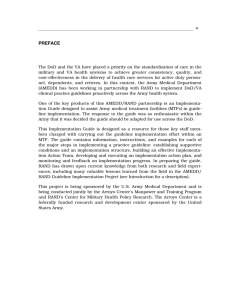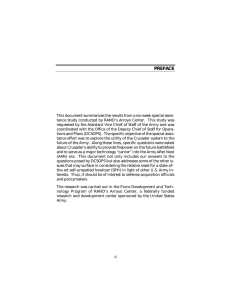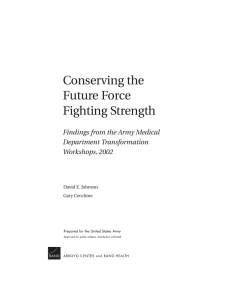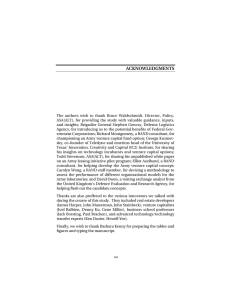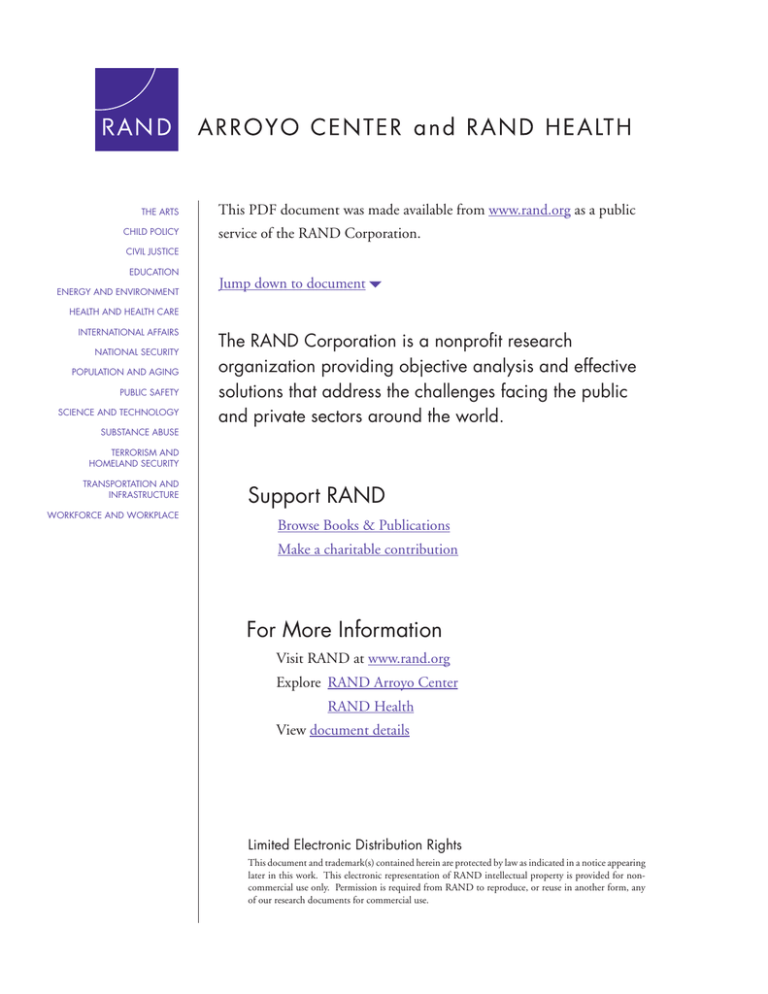
THE ARTS
CHILD POLICY
This PDF document was made available from www.rand.org as a public
service of the RAND Corporation.
CIVIL JUSTICE
EDUCATION
ENERGY AND ENVIRONMENT
Jump down to document6
HEALTH AND HEALTH CARE
INTERNATIONAL AFFAIRS
NATIONAL SECURITY
POPULATION AND AGING
PUBLIC SAFETY
SCIENCE AND TECHNOLOGY
SUBSTANCE ABUSE
The RAND Corporation is a nonprofit research
organization providing objective analysis and effective
solutions that address the challenges facing the public
and private sectors around the world.
TERRORISM AND
HOMELAND SECURITY
TRANSPORTATION AND
INFRASTRUCTURE
WORKFORCE AND WORKPLACE
Support RAND
Browse Books & Publications
Make a charitable contribution
For More Information
Visit RAND at www.rand.org
Explore RAND Arroyo Center
RAND Health
View document details
Limited Electronic Distribution Rights
This document and trademark(s) contained herein are protected by law as indicated in a notice appearing
later in this work. This electronic representation of RAND intellectual property is provided for noncommercial use only. Permission is required from RAND to reproduce, or reuse in another form, any
of our research documents for commercial use.
This product is part of the RAND Corporation technical report series. Reports may
include research findings on a specific topic that is limited in scope; present discussions of the methodology employed in research; provide literature reviews, survey
instruments, modeling exercises, guidelines for practitioners and research professionals, and supporting documentation; or deliver preliminary findings. All RAND
reports undergo rigorous peer review to ensure that they meet high standards for research quality and objectivity.
Medical Risk in the Future
Force Unit of Employment
Results of the
Army Medical Department
Transformation Workshop V
David E. Johnson, Gary Cecchine
Prepared for the United States Army
Approved for public release; distribution unlimited
The research described in this report was sponsored by the United States Army under
Contract No. DASW01-01-C-0003.
Library of Congress Cataloging-in-Publication Data
Johnson, David E., 1950 Oct. 16Medical risk in the future force unit of employment : results of the Army Medical Department
Transformation Workshop V / David E. Johnson, Gary Cecchine.
p. cm.
“TR-302.”
“This report continues the task of documenting the Army Medical Department’s (AMEDD) process of
identifying and addressing medical issues related to the Army’s transformation to the Future Force. It describes
the AMEDD Transformation Workshop (ATW) V, conducted at the RAND Corporation Washington Office
25–28 May 2004, and includes an analysis and discussion of the workshop results.”—Pref.
Includes bibliographical references.
ISBN 0-8330-3905-9 (pbk.)
1. United States. Army—Medical care. 2. United States. Army Medical Dept. 3. United States. Army—
Reorganization. I. Cecchine, Gary. II. Rand Corporation. III. United States. Army Medical Dept. IV. Army
Medical Department Transformation Workshop (5th : 2004 : Washington, D.C.) V. Title.
[DNLM: 1. United States. Army—Congresses. 2 United States. Army Medical Dept—Congresses.
3. Military Medicine—organization & administration—United States—Congresses. 4. Delivery of Health
Care—organization & administration—United States—Congresses. WB 116 J66m 2006]
UH223.J665 2006
355.3'450973—dc22
2005036286
The RAND Corporation is a nonprofit research organization providing objective analysis
and effective solutions that address the challenges facing the public and private sectors
around the world. RAND’s publications do not necessarily reflect the opinions of its
research clients and sponsors.
R® is a registered trademark.
© Copyright 2006 RAND Corporation
All rights reserved. No part of this book may be reproduced in any form by any electronic or
mechanical means (including photocopying, recording, or information storage and retrieval)
without permission in writing from RAND.
Published 2006 by the RAND Corporation
1776 Main Street, P.O. Box 2138, Santa Monica, CA 90407-2138
1200 South Hayes Street, Arlington, VA 22202-5050
201 North Craig Street, Suite 202, Pittsburgh, PA 15213-1516
RAND URL: http://www.rand.org/
To order RAND documents or to obtain additional information, contact
Distribution Services: Telephone: (310) 451-7002;
Fax: (310) 451-6915; Email: order@rand.org
Summary
This report documents the Army Medical Department’s continuing process of identifying
medical issues in the Army’s transformation to the Future Force. It contains an assessment of
the AMEDD Transformation Workshop (ATW) V; describes the workshop’s organization,
objectives, scenario, and analysis methodology; and provides observations and conclusions.
The purpose of this workshop was to continue the assessment, begun in ATWs I–IV,
of the medical risks associated with emerging Army operational concepts and the capacity of
the AMEDD to mitigate these risks. ATWs I–III focused on medical risk in a Unit of Action
(UA) within a theater that had a defined echelons-above-UA Health Service Support (HSS)
system (a 44-bed Combat Support Hospital [CSH]). Based in part on these initial workshops, the AMEDD determined that a 44-bed CSH would likely be insufficient, and it set
out to determine what HSS system would be required at echelons above UA. ATW IV assessed the medical risk and demand on an echelons-above-UA HSS system that 76 casualties
from a single UA would create during a simulated 12-hour battle. The principal focus of
ATW V was to continue the process of establishing the casualty demand data that must be
addressed by the echelons-above-UA HSS system. It involved four UAs (and supporting
units of employment [UE]) with 429 casualties over a 100-hour simulated battle. Thus, the
principal purpose of ATW V was to provide analytical support to the AMEDD to assist it in
designing the HSS system above the UA level.
Background
The Army’s transformation to the Future Force not only posits dramatically different
equipment, it also envisions radically new ways of fighting. One aspect of future Army operations that is of particular importance is the employment of widely dispersed units moving
rapidly across the battlefield. These operational concepts potentially pose significant challenges for the units that support the combat elements. In 1998, the AMEDD began an analytical effort to gain insight into the challenges for HSS posed by emerging Army transformation concepts. Over the next few years, AMEDD conducted two games and several
workshops to provide further insight into how it could best support the Army as it transformed.
xi
xii
Medical Risk in the Future Force Unit of Employment: Results of ATW V
AMEDD Transformation Workshop V
In collaboration with the Center for AMEDD Strategic Studies, RAND designed, organized,
facilitated, and provided analytic support to the fifth in a series of ATWs, conducted from
25–28 May 2004. The workshop was supported by subject matter experts (SMEs), who examined the ability of an envisioned UA HSS structure to support Future Force combat operations, as employed in a scenario provided by the U.S. Army Training and Doctrine
Command (TRADOC).
Casualties Were Determined Based on an Army Scenario and Simulation Results
Casualty data for ATW V were provided by the AMEDD, which derived it from simulation
casualty data, based on a Caspian 2.0 scenario, provided by the TRADOC Analysis Center
(TRAC).1 The approximately 100-hour battle resulted in 429 casualties among the four UAs
and soldiers from the UE x and UEy in the UA’s area of operations (AO).2 Figures S.1 and S.2
show the distributions of the causes of the casualties and their wound types, respectively.
Figure S.1
Causes of Injuries of 429 Casualties
60
224
50
Percentage
40
141
30
20
38
10
22
4
0
Explosion
Blunt
trauma
Burn
Penetrating
wound
Drowning
Injury cause (number)
RAND TR-302-S.1
____________
1 Technically,
soldiers wounded or killed are known as casualties. They are referred to as patients once they have entered the
medical system above the level of first responder (e.g., combat medic) care. For simplicity, we use the term casualty throughout this report.
2 UE
x
and UEy are the two command echelons above the UA.
Summary
xiii
Figure S.2
Types of Injuries of 429 Casualties
35
30
124
Percentage
25
20
73
67
15
56
52
10
22
5
9
19
4
3
0
Head, face Head and
and/or extremities
eye
Chest
Abdomen
Spine
Burn
Upper
extremity
Lower
Drowning Superficial
extremity
Injury type (number)
RAND TR-302-S.2
The simulation for ATW V depicted Future Combat System (FCS)-equipped maneuver UAs, operating as part of a UEx and UEy , conducting an attack to isolate the enemy’s
capital city and defeat enemy forces as part of the overall campaign objective of reinstating a
legitimate government. The UEy operated in a physical battlespace of over 500 kilometers by
225 kilometers.
The results of this UE-level simulation were the most current available for ATW V.
How representative they are of what might occur in future operations is unknown, given the
limited number of Army Future Force simulations conducted as of time of ATW V. More
simulations are necessary to validate and expand the utility of these outcomes for Army force
structuring and concept development efforts.
ATW V Questions and Answers
The workshop SMEs were asked to answer the following questions:
• What was the disposition of casualties (casualty outcomes) at the end of the scenario?
• What was the status of the HSS system at the end of the scenario?
• How many casualties required further evacuation and treatment at echelons above the
UA?
xiv
Medical Risk in the Future Force Unit of Employment: Results of ATW V
What Was the Disposition of Casualties (Casualty Outcomes) at the End of the Scenario?
The Vector-in-Command (VIC) simulation generated 1,102 loss-producing events that resulted in 429 wounded-in-action (WIA) casualties during the approximately 100-hour battle.
The percentages of casualties who died of wounds (DOW) and who died prior to reaching a
medical treatment facility (killed in action [KIA]) in ATW V were similar to those in previous workshops, even though they were based on different scenarios (Johnson and Cecchine,
2004). This similarity is likely because of the robustness (or lack thereof) of the UA HSS system, the types of combat operations depicted in the scenarios, and similar (and plausible)
estimations of casualty distributions based on the simulations.
A significant difference from past workshops was the higher rate of limb loss estimated in ATW V. While some of this difference may be attributed to better methods of estimation, because ATW V participants were directed to document likely amputations more
clearly than in past workshops, it is nonetheless worth noting. Limb loss occurred in 58 casualties, representing 13.5 percent of all casualties. A portion of these limb losses were likely
unpreventable, based on the description of their wounds. However, 22 casualties were described as having salvageable limb wounds but were amputated nonetheless, representing 38
percent of the total estimated limb loss events.
What Was the Status of the HSS System at the End of the Scenario?
As in previous workshops, the HSS systems in the UAs operated at or near capacity for most
of the duration of the scenario. Surgical capabilities were the most taxed: UA Forward Surgical Teams (FSTs) performed 118 surgeries, totaling approximately 114 surgical hours, not
including pre- or post-operative procedures. The medical demand, however, was not evenly
distributed among the UAs, ranging from 18 to 46 cases among them. Not surprisingly, the
FST that performed the most surgeries also experienced the greatest delay times from
wounding to surgery. To handle surges in demand, the workshop SMEs carefully managed
the triage of surgical patients in consideration of the austere surgical capability, often
“bumping” patients in favor of others more critically wounded. This practice, enabled by
remote triage capabilities, likely contributed to the elevated risk of limb loss, as a result of
delayed surgery of vascular extremity wounds in favor of life-saving surgery for another casualty.
Evacuation assets were also used near capacity during the scenario. The dispersion of
the battlefield and number and timing of casualties requiring evacuation and care contributed in some cases to long delays before a casualty reached surgery (for those requiring surgery); however, the surgical load also contributed to this delay, and it is difficult to determine
precisely the contribution of evacuation asset availability.
How Many Casualties Required Further Evacuation and Treatment at Echelons Above the
UA?
Similar to ATW IV, approximately two-thirds of casualties required evacuation to higher
echelons. Of these, nearly 80 percent were classified as “urgent” or “priority,” and approximately two-thirds would require surgery at echelons above the UA. Partially because of an
early peak in the casualty flow in the scenario, the number of casualties requiring evacuation
from the UAs similarly peaks early in the battle. This trend suggests the need for robust HSS
capabilities at echelons above the UA fairly early in this scenario.
Summary
xv
Workshop Observations and Conclusions
Observations
The complete effect of the casualties on the HSS system is not known at this juncture, because ATW V could examine the effect only on the UA system, given that the HSS system at
higher echelons has yet to be fully developed. Similarly, it is important to note that the final
disposition of those casualties who are awaiting evacuation to echelons above the UA is not
completely certain. In the time beyond H+100 hours,3 the percentage of DOW casualties
likely will either remain the same or increase, given that some seriously wounded casualties
awaiting evacuation could die during the wait. In other words, nearly two-thirds of the casualties were determined to be ready for evacuation to higher echelons, and their disposition
will necessarily depend upon capabilities at those echelons.
This workshop was designed primarily to analyze the residual demand that multiple
UAs will place on the echelons-above-UA HSS system for a specific scenario. Consequently,
if a UA could not adequately deal with a casualty, it was assumed that the casualty would be
evacuated to an echelons-above-UA HSS system component that could. The HSS system in
the UAs was heavily taxed, and the residual demand for evacuation and care at higher echelons was similarly significant.
Conclusions
ATW V provided valuable insights into the ability of AMEDD’s envisioned Future Force
HSS system to support a Future Force operation. This workshop also continued the process,
begun in ATW IV, of determining the demand that an echelons-above-UA HSS system will
be required to meet in Future Force operations. Although the results and insights gleaned
from ATW V are unique to a specific scenario and simulation, they do point to the potential
medical challenges posed in supporting rapid Future Force operations on a highly dispersed
battlefield.
The workshop also reinforced the importance of simulating Future Force concepts
and the criticality of in-depth, subject matter expert analysis in assessing the outputs of any
simulation. In the case of this workshop, every casualty generated by the simulation was
tracked from the point of wounding through the UA HSS system by experts in all the components of combat casualty care. Thus, the teams were able to articulate credible casualty
outcomes and the challenges facing emerging AMEDD concepts, structures, and technologies in supporting postulated Future Force operations. The team members stressed that further simulations of additional scenarios of evolving Future Force concepts are needed to ensure that the AMEDD can articulate to the Army the medical risks involved in those
concepts and the ability of the future HSS system to mitigate those risks to a level acceptable
to the Army. Such analysis will support the design and implementation of an HSS system
capable of conserving the fighting strength of the Army’s Future Force.
____________
3 The DOD Dictionary of Military and Associated Terms (Joint Doctrine Division, 2005) defines H-hour as “the specific
hour on D-day at which a particular operation commences.”

